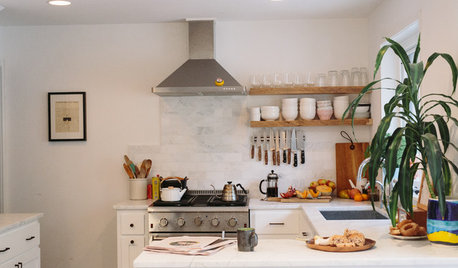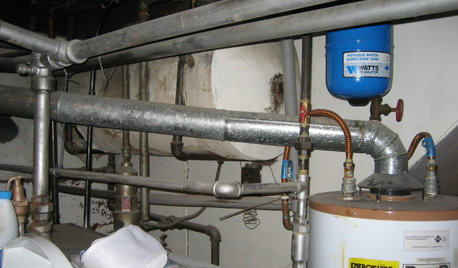Asbestos Mastic
Good Evening,
Thank you in advance for your help. I'm completing a kitchen renovation in my 63 year-old home. When I removed the lower cabinets, I discovered some asbestos (I believe) tile. The tile wasn't in squares, but appeared to be in longer sheets (I put a pry bar under it and it all popped up in a single sheet). This tile/sheet was adhered to the hardwood floor under the cabinet and, after being removed, left a think black layer. Since some of this hardwood floor would be exposed in the new renovation, I took a sharp knife and scraped a small portion of the black layer away. I then hand sanded a small portion to get to the wood.
To my surprise, I learned tonight that asbestos can be found in mastic and am now very concerned that my sanding has caused a series problem. Fortunately, I only sanded roughly 1 square foot. Since some experts seem to post on this forum, I'm curious about the type of health damage I inflicted today. I realize sanding is probably the worst thing I could have done to the mastic now, but, since the area was small, should I have concerns or am I fretting needlessly? Thank you!
James
Comments (19)
karinl
13 years agoIsn't it the white mastic that contains asbestos? I didn't think the black stuff did, but I could be wrong.
I know the feeling of lying awake at night and going "why did I do that?? How could I be so stupid??" but I think in this case you can congratulate yourself for having hand sanded. This limited the spread of dust. Now your task is to try to clean up as much of the dust as you can.
The basic principles of working with asbestos are working wet, and containment. So you could just wipe with damp rags/paper towels. I wouldn't do any vacuuming unless it's with a good vacuum cleaner with a hepafilter (we bought a Miele for an outrageous price last year and those "I wonder if this is asbestos" moments make it seem worthwhile - even if it doesn't catch it all, it will catch more than the 20-year-old Hoover did!). And be sure your vacuum outflow isn't positioned so as to blow the stuff around.
This is a reminder too to pretty much always work wearing a mask when you take stuff apart. You just never know what you're dealing with. As with the vacuum, even if it doesn't get it all, it's better than nothing.
Your exposure will really have been minimal in any case. Most of us probably have worse asbestos "oops" stories. For me, after living in my house for 18 years it's just dawned on me that the popcorn ceilings in the basement are probably asbestos (having them tested this week). We bump that ceiling and knock little bits off it all the time, and my husband has cut holes to run wires and stuff quite regularly. So far, no health impacts.
KarinL
Related Professionals
Barrington Hills Kitchen & Bathroom Designers · Clute Kitchen & Bathroom Designers · Everett Kitchen & Bathroom Designers · Fox Lake Kitchen & Bathroom Designers · Haslett Kitchen & Bathroom Designers · Williamstown Kitchen & Bathroom Designers · Elk Grove Village Kitchen & Bathroom Remodelers · Lakeside Kitchen & Bathroom Remodelers · Lincoln Kitchen & Bathroom Remodelers · Linton Hall Kitchen & Bathroom Remodelers · Port Angeles Kitchen & Bathroom Remodelers · Roselle Kitchen & Bathroom Remodelers · Vista Kitchen & Bathroom Remodelers · Eufaula Kitchen & Bathroom Remodelers · Los Alamitos Architects & Building DesignersBilll
13 years agoAsbestos is an issue because the fibers are small enough to go airborne and be inhaled but large enough to get stuck in your lungs. When that happens, your lung tissue can get inflamed and cause all sorts of health issues. Your body naturally will get rid of asbestos, but it is slow going. A 1 time exposure isn't going to cause noticeable irritation in an otherwise healthy person. It also isn't going to give you cancer. The serious side effects come when you get large amounts of this stuff in your lungs over a long period of time. It is kinda like smoking. One cigarette might make you cough, but it is the 2 pack a day habit that causes the real problems.
As for what to do, the most conservative approach would be to take the steps that an abatement company would. Basically, you air the place out and wipe it down. The pros would bring in high power ventilation systems, but you can just open windows on the far side of the house and put fans facing out in the kitchen windows. Then, you would follow up by using damp cloth to wipe down surfaces so the dust doesn't become airborne again. Swap out any air filters in your ventilation system so you don't accidentally recirculate any dust trapped in them. That would be complete overkill for the potential "danger" you described, but it would be a cheap and easy way to ease your mind if this is keeping you up at night.
kudzu9
13 years agojryand17-
I'm very cautious around asbestos-containing materials as I used to be involved as an environmental engineer with removals. Having said that, I think you should not worry about this particular situation too much:
1. It was a small area.
2. You don't know if it contains asbestos (although it is possible).
3. With asbestos-containing mastic, the actual asbestos content can be a relatively low percent.
4. You are already exposed to a small amount of asbestos every day as it floats around in the air as a background pollutant from many sources so it's not like this is the one exposure to asbestos that will give you cancer in 20-30 years.
5. Continuing to worry will not improve the situation.So, take this as a valuable learning experience abut remodeling and, in the future, get suspect materials analyzed at a certified test lab before messing with them. If you have any dust from the sanding still around, don't vacuum (the particles go right through the filter of a regular vacuum and get re-suspended; instead, do a wipe with moist paper towels.
Now, if you fasten your seat belt when driving, look both ways when you cross the street, and quit smoking, you'll have greatly reduced the major risks in your life which are much more threatening than this little episode.
ideagirl2
13 years agoI wouldn't worry. You need long exposure at high levels to create a health risk.
"Long exposure" and "high levels" is pretty vague. Malcolm McLaren, the former manager for punk group the Sex Pistols, died last year of mesothelioma; his only known asbestos exposure was the ceiling panels he ripped out in his clothing store in London in the early/mid 1970s. Apparently he took them down, broke them into pieces and left them laying around for a few years as decoration--his goal was to make the shop look like a bomb had hit it.
So it's not like you have to spend your career in an asbestos factory to get mesothelioma. And black mastic can (but doesn't always) contain asbestos. But yeah, what Jryand described was minimal. That being said, the advice everyone has given on how to deal with that kitchen without breaking, dry-scraping or sanding any more asbestos is great. And also, Jryand, did you get the tile and mastic tested? Asbestos testing isn't expensive--for my floor mastic I was quoted $25 (I had a few pieces in a ziploc, they didn't have to come out and get it themselves)--and certainly worth it for the peace of mind.
worthy
13 years ago"Long exposure" and "high levels" is pretty vague.
According to footnoted references in Wiki and WebMD, documented cases indicate exposure of as little as one-three months can result in the disease.
I'll trade with the OP.
In a five-plex I renovated with a partner in 1989, at one point he had the workers use handscrapers to remove sprayed-on asbestos from all the boiler pipes. I spent only a few minutes in the dust. But I was around that property for the next few months. Wonderful.
attofarad
11 years agoI'm bumping this thread to see about the best way to remove some mastic. It was used in the 60's to glue ceramic tile directly to plywood subfloor. The tile has been removed, and I had the mastic checked for asbestos. The report came back 2% asbestos content.
What is the best way to remove this mastic? It sands quite readily, but that seems a bad thing.
kudzu9
11 years agoattofarad-
Although 2% is a fairly low level, I can guarantee you that sanding it is the most effective way to create a hazard, and that your local pollution control agency would not be happy if they found out that you removed it that way.What do you intend to do with this floor next? Often the best approach is to adhere another substrate -- like 1/4" Hardiboard -- on top and not bother with further removal. If you don't want to raise the level of the floor at all, other than to put something like seamless vinyl down, there are bonding agents you could put on top of the remaining mastic.
attofarad
11 years agoKudzu, the intent was preferably put down Ditra and re-tile. I could also do hardwood there. A small part (25 sq ft out of 370 total) is in a bath that will definitely be tiled.
kudzu9
11 years agoattofarad-
Putting something over it poses no risk and presents no continuing hazard. How well Ditra would bond to the mastic is something I don't know about, so would refer you to that company for info. Something else, like a hardwood floor -- with or without additional underlayment -- is an easy solution.The only other thing that I should mention is that, if this is a house, and the mastic stays in place, then you may have to disclose the presence of those asbestos-containing materials when you sell the place, even though it is only at 2%. This particular situation should not be a concern for any prospective buyer, but a few uninformed folks might be concerned, or try to use it as a bargaining point. If it were me, I'd leave it in place and put something over it as you described.
snoonyb
11 years agoThe discussions on this subject are voluminous in these forums.
A simple google search for asbestos containing linoleum or tile will lead you to "cutback" adhesive.
Here is the story;An interesting discussion, linoleum, and possibly cut-back adhesive.
This product, as with all products containing asbestos as the binding agent only atain a "hazardos" status when they become "friable", iE airborne.
Since there was a lack of consistency, state to state, for the remediation of these products, encapsulation became the method of choice and so, many have been simply covered over with "safe" products, such as Hardie-backer.The simple test that determines whether or not cut-back adhesive is present is to spill boiling water on an exposed area. If the water puddles, you have cut-back adhesive, if the adhesive melts, you do not.
The solution in the removal process is to keep the area moistened which will serve to prevent the binder from becoming friable.
There are also several products which work quite well for adhesive removal.ruiz
10 years agoI've read about this and now I am so concerned about my health. I had lived in an old house, in a room (10x15ft)that had the tile taken off the floor looked just like that!! I was mastic floor, literally. I had lived there for almost ten years and the floor had never been fixed, There are still some tiles on the corners, but most of the floor in the room is mastic.Should I be worried about the asbestos expusure I have been through? How Can I fix the floor myself? Please help... In my case it was not just a small area and not for a short period of time. I mop the floor to try to get rid of the black stuff (mastic) it had faded away over time on some small areas...
ruiz
10 years agoI've read about this and now I am so concerned about my health. I had lived in an old house, in a room (10x15ft)that had the tile taken off the floor looked just like that!! I was mastic floor, literally. I had lived there for almost ten years and the floor had never been fixed, There are still some tiles on the corners, but most of the floor in the room is mastic.Should I be worried about the asbestos expusure I have been through? How Can I fix the floor myself? Please help... In my case it was not just a small area and not for a short period of time. I mop the floor to try to get rid of the black stuff (mastic) it had faded away over time on some small areas...
james Yang
3 years agoI may have asbestos mastic as well and I just broken a few tiles then found they are black adhesive. In this case, I know I can cover up all other tiles, but how about the borken tiles with black mastic, does this mean it was disturbed, so airborne might have been released already? Do I need to do asbestos airbrone test?
kudzu9
3 years agolast modified: 3 years agoIt doesn't sound like it was a big enough disturbance to worry about. Air testing won’t tell you anything: there is always a low, but measurable “background level” of asbestos fibers in the air, so even if you got a positive result back, it would be slight, and you would have no way of knowing where the fibers came from. And it would certainly not be anything that would trigger a cleanup.
james Yang
3 years ago@kudzu9 Thanks a lot. I don't expect so quick response since this post is so old. Originally, I just want to find what was the manufacture of old tile to exactly match while tile then make up empty space in the floor.
My bad is that I used dremel to cut grout then use chisel kick out 4-5 tiles, also rotary a few black mastic parts , want to see some marks which may show manufacture info.Meanwhile, I used dry/wet vaccum to absorb dust.
then I realize there are black mastic underneath the tile, may be related to asbestos since house was buit in 1968.
that's why I am concerned about airborne?
kudzu9
3 years agoI still think you’re ok. If there were fibers in the mastic — which you don’t know — they are pretty tightly bound by the other components, so in a small area I wouldn’t expect a significant release even though you did some grinding. Whatever was released, if anything, is likely long gone due to the many air changes that occur on a daily basis in any dwelling. The only thing I can think of at this stage is to dump the shop vac‘s contents into a trash bag, clean the inside of the vac with a wet paper towel, seal the bag, and dispose of it. If you think there is any residual dust in the room where you did the work, do a wet wipe of that as well.













worthy